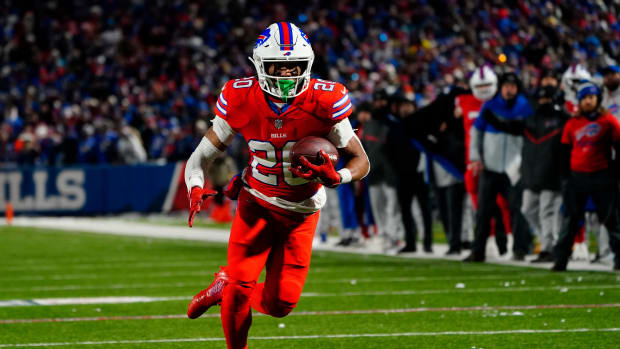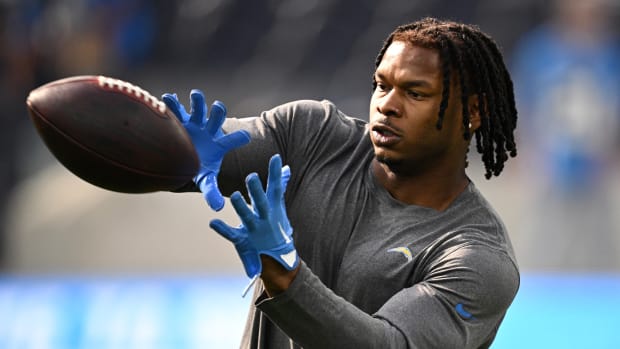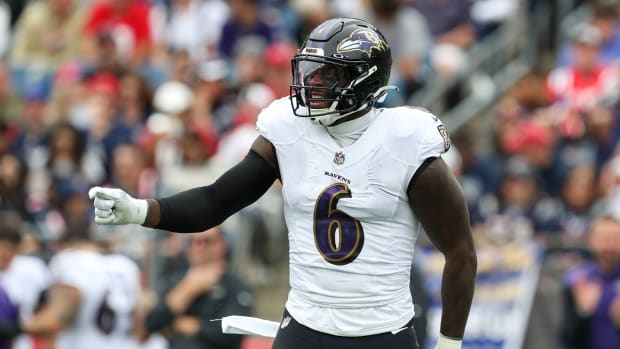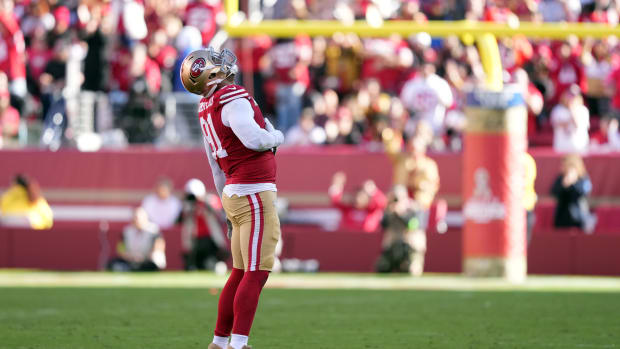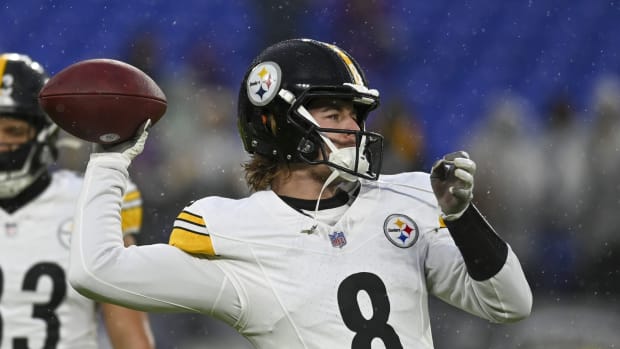
The MMQB 2013 Reflections
We're particularly fond of 2013 here at The MMQB. It's the year, as you may know, that we launched this site without much in the way of a mission statement except trying to provide for readers a new perspective on a game we all love and spend so much of our lives dedicated to.
We had no idea, when we pushed the button that birthed The MMQB on July 22, how it would be received, so six months later with the year wrapping up, we want to thank everyone who's read even just a word of word of what we've done. It's been a great experience for all involved. Below, our four staff writers reflect on a memory from the year that strikes them as most poignant as we turn the calendar over to 2014.
For more, check out our top 100 photos from the 2013 season. Happy New Year, everyone.
Peter King
CHICAGO—I’m in the van with the Gene Steratore officiating crew after a 23-20 Chicago victory over Baltimore at Soldier Field in November. This has been one of the most interesting weeks in my reporting life, being able to be behind the curtain with a crew of officials, because these seven men are usually treated like CIA agents. You don’t know them, you don’t talk to them ... they don’t exist, except for three hours on Sunday, when millions of Americans pass judgment on how awful they are, and how they are ruining the game so many people love. But after some long conversations with NFL people, I’d gotten permission to spend a week with this crew and to write whatever I see. It was enlightening.
Steratore, a 50-year-old referee, is one of the league’s best. And so here he was, across the aisle in this van, on the way to O’Hare and a flight back home to western Pennsylvania, and I brought up something that was troubling to him.
"What about the late hit on Julius Peppers you called?" I said.
Read the three-part series
Part I—The Ref: Gene Steratore
Part II— The Crew
Part III—The Test: Ravens at Bears
Creases on his forehead. Sort of a disgusted look on his face.
"Are you kidding? That’s a flag. Easy. After last week?" he said.
The play: With 5:51 left in the first half, Joe Flacco scrambled for a first down, slid, and was hit during his slide by Peppers. Steratore threw the flag, and he called unnecessary roughness on a sliding quarterback who’d given himself up. Peppers immediately threw his hands in the air, angry. Borderline call. But after getting whacked for two hits on the quarterback seven days earlier, Steratore had entered this game with more of an itchy trigger finger. "Whacked" in this case means he’d been downgraded—the worst punishment for an official short of a game suspension—on two plays because the league graders thought he should have called unnecessary roughness twice the previous week when he’d kept his flag in his pocket. Plus, during the weekly pre-game meeting on Saturday, league officiating supervisor Gary Slaughter had told the crew, "Guys, the biggest thing on our radar is UNR [the three-letter abbreviation in ref parlance for unnecessary roughness]. Roughing the quarterback, stay after those. Remember, we want you to err on the side of safety."
In the league’s quest to make the game safer, the officials were constantly on the prowl for the kinds of fouls that appeared ticky-tack to some—such as the marginal Peppers hit on Flacco, which in real time looked like a gentle hit. Certainly there was contact, but it wasn’t much. So much of my time with this crew in five different cities in seven days was spent talking about safety and UNR. I came away thinking: These guys cannot get every one of these right, but they’re being watched so carefully by the league that they’ve got to make calls like the Peppers call. It’s too much of a game of Russian Roulette not to.
"A few minutes later," Steratore told me there in the van, "I walked up to Julius during a TV timeout and said, ‘Look, Julius, if that play happened in my backyard, I’m not calling it. But I get graded too, just like you.’ He said, ‘I understand.’ "
Postscript: When the game was graded, Steratore got a "support-only" grade from the league. Meaning the NFL doesn’t think he should have made the call, but he won’t be graded negatively for it.
I didn’t see Steratore after that Sunday night, but if I were him, and I saw that "support-only" grade come across my laptop on Tuesday morning, I’d have thrown my hands in the air and said, My God. What do you want me to do?
Greg A. Bedard
When I think back to this wacky first year at The MMQB, one in which I saw everything from police executing a search warrant at Aaron Hernandez’s house to Peter King standing in our GoRVing.com vehicle belting "Like a Rolling Stone" at 3 a.m. on our training camp tour, I think my favorite moment was at Chiefs camp at Missouri Western State University in St. Joseph, Mo. The teams I had previously covered (the Dolphins, Packers and Patriots) all trained at their own facilities, so it was a different experience to see a team out on its own, and a pretty cool setting to boot. It was open and relaxed—how I’m guessing it used to be for most teams. And it afforded me an opportunity to evaluate another team in a setting that is usually very telling: a full-padded practice. It didn’t take very long to notice that the Chiefs were big and athletic on all three levels of the defense, and that defensive coordinator Bob Sutton was using the Jets' scheme he learned from Rex Ryan to put players in position to succeed. The Chiefs were attacking from different places on every snap. I was impressed. Didn’t look like a 2-14 team, which the Chiefs were in 2012, to me.
After walking up from practice with general manager John Dorsey, who I knew from our time in Green Bay, we sat on a bench overlooking the fields and he asked me what I thought. "Well, it looks like you’re going to have a chance to field a dominant defense, which means you’re going to at least be in the hunt." I barely got the words out when Dorsey started barking. "Don’t you go writing that! That’s all we need is for people to be expecting this or that. We’re trying to build a championship team here. It’s not going to happen overnight."
Well, I picked the Chiefs to win the AFC West over the Broncos, which didn’t happen. But Kansas City did start 9-0 and made the playoffs at 11-5, largely on the strength of their defense and running back Jammal Charles. Sorry John, you’ve got expectations heaped upon you now. That’s your own doing.
Go to Page 2 for Robert Klemko's and Jenny Vrentas's reflections at the year's end.
Robert Klemko
For me, the biggest rush in this profession comes the night before a big story is about to run. I can’t sleep. I stay up until 5 or 6 a.m. laying in bed, wondering how it will be received. On Day 2 of our The MMQB experiment, we published a story in which two former NFL players who were gay offered advice to their younger selves. I stayed awake all night, hoping I had done Wade Davis and Esera Tuaolo justice after they spilled the story of their lives to me over the phone. I hardly considered how the piece would affect the other people who read the story. And then it ran, and I got this Facebook message at 11 a.m. from "Linda" in Ohio (she asked that her identity and location be kept confidential):
I've come to Facebook to message you, as I'm a bit afraid to post on the MMQB story you posted today, 'Gay in the NFL.' The timing for your article could not be better. You see, my 15 year old son came out to me last night.
Linda was afraid for her son, who would soon come out to several more family members and friends. She was stunned, not because she hadn’t suspected it (she had), but because it was finally real, on a Tuesday morning in July. She believes homosexuality is not a choice, but she hadn't put much thought into it otherwise until then. She said Tuaolo's and Davis’s words were a revelation, setting in motion over the next several weeks and months a rapid education on what it is to be gay.
I was humbled. It's truly rare, when so much of the default reaction to the stories we do is anger or ridicule, to have somebody reach out to say that a story helped them.
Two former players describe the struggle of growing up closeted in the world of football FULL STORY
I kept in touch with Linda. Know that she’s in her 40s and loves the Steelers because her mother loves the Steelers. Her son has never played football, but he’s an athlete, and his growing interest in the NFL excites her. Most of Linda’s friends are liberal, but some peers of her and her son believe homosexuality is both a choice and a sin. When a
GQ
story came out in which
Duck Dynasty
reality TV dad Phil Robertson compared homosexuality to bestiality, their Facebook feeds ran deep with teens and adults supporting his comments, and slamming TV network A&E for suspending him (temporarily) from the show. Linda wrote me, "It's unfortunately been a wake-up call for him when it comes to people in his life, not knowing his orientation, posting opinions on things like sinfulness and burning in hell." He was hurt, but he kept reading, and he kept asking questions. One night while watching football he asked Linda, "Are there gay guys in the NFL?"
So she showed him my story; the one Davis and Tuaolo were brave enough to tell, which Peter King and Sports Illustrated were brave enough to run uncensored, and which I was blessed to relay to our readers.
"He was afraid, as anybody would be, to come out," Linda told me. "He's learned from reading and from friends how to relate. The big thing he learned from that story is that he's not alone. He was amazed."
Thanks, kid. You're amazing. I hope you keep reading, and know that football can be this awesome window into the human condition if you look at it through the right lens. For me, and The MMQB in 2013, drawing back the shades was both our distinct pleasure and greatest aspiration.
Jenny Vrentas
Chip Kelly’s Eagles made their much-anticipated debut in primetime Week 1, fittingly, and that’s when we in the NFL world all saw those fantastically oversized play cards for the first time, too. The Twitter-sphere had a ball calling out the images as they appeared: The Phillie Phanatic! Rocky!
I had a slightly different reaction: Hey, isn’t that the sports-science coordinator holding those play cards?
To get the most out of his players, Kelly is turning the Eagles into a performance laboratory—but who’s that at the controls? FULL STORY
The backstory was that I’d spent many hours in the spring and summer trying to learn more about Chip Kelly’s Mystery Man (that was, in fact, the title of
the story we ended up publishing in July
). I’d struggled even to get so much as a glimpse of Shaun Huls, and the only photograph we could run with the story was a mugshot from the team website translated into an extreme close-up of his eyes (which apparently generated some chuckles inside the team’s NovaCare Complex).
The question, of course, was the same one that surrounded Kelly’s entry into the NFL: What changes will the Oregon mastermind’s regime bring to the pro game, and will they work? I write about this, in our year-end reflections, two days after Kelly’s team wrapped up the NFC East crown and a home playoff game. The coach’s rookie season has been an impressive answer to any skepticism his move to the NFL solicited. And for all the hype about those personalized smoothies or that loud music at practice, the sports-science program looks pretty good in its maiden voyage, too.
At the end of the regular season, the Eagles have just five players on injured reserve, which, by a cursory count, looked to be tied with two other teams (the Ravens and the Bears) for the fewest in the league. This, to me, is even more remarkable: According to the transaction log on the team’s website, the Eagles have made just one injury-related roster move since the season began (placing CB Brandon Hughes on short-term injured reserve and then waiving him with an injury settlement). The Eagles lost four players to ACL tears in the preseason, but how rare is it to make it through a regular season without any players suffering season-ending injuries?
You don’t want to blow this out of proportion: Many injuries are bad luck, the sample size is just one year, teams not in playoff contention are more likely to shut players down at the end of the season, etc. But when you see a team with all 53 players practicing on Dec. 12 (as CSNPhilly reporter Geoff Mosher posted on Twitter that day), you can’t help but wonder the significance of techniques like tracking the stress on a player’s body during each workout with wearable microcomputers, or quantifying their readiness for training with electrodes that link to the central nervous system.
Learning about the Eagles’ sports-science program, despite its shroud of secrecy, made me look differently at not just the card-holder on the sideline, but at player health, management and injury prevention. And I wonder how much the Eagles’ success has influenced perspectives elsewhere in the league, too.




































